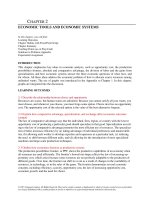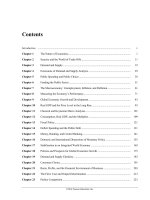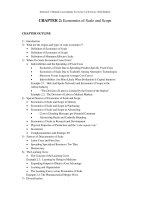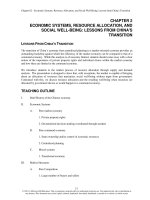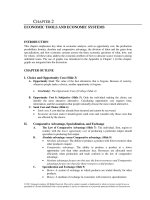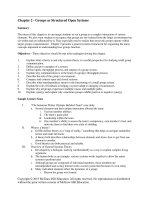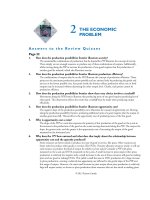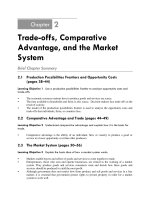Test bank and solution manual of economics systems and resources allocation (2)
Bạn đang xem bản rút gọn của tài liệu. Xem và tải ngay bản đầy đủ của tài liệu tại đây (1.42 MB, 24 trang )
RG21e_IM_Ch02.pdf
RG21_PPT_Ch02.pdf
Chapter 02 - Economic Systems, Resource Allocation, and Social Well-Being
CHAPTER 2
ECONOMIC SYSTEMS, RESOURCE ALLOCATION, AND
SOCIAL WELL-BEING
LESSONS FROM CHINA’S TRANSITION
The transition of China’s economy from centralized planning to a market-oriented economy provides
an outstanding backdrop against which the efficiency of the market economy can be compared to that
of a command economy. While this analysis is of necessity limited, students should come away with a
clear notion of the importance of private property rights and individual choice within the market
economy and how these are limited in the command economy.
We introduce students to the market process of resource allocation through supply and demand
analysis. The presentation is designed to show that, with exceptions, the market is capable of bringing
about an allocation of resources that maximizes social well-being without input from government.
Contrasted with this, we discuss resource allocation and the resulting well-being when resources are
allocated by government decree as would happen in a command economy.
TEACHING OUTLINE
I.
Brief History of the Chinese economy
II.
Economic Systems
A.
Pure market economy
1. Private property rights
2. Decentralized decision-making coordinated through markets
B.
Pure command economy
1. State ownership and/or control of economic resources
2. Centralized planning
C.
Mixed systems
1. Transitional economy
III.
Market Structures
A.
Pure Competition
1. Large number of buyers and sellers
2-1
© 2016 by McGraw-Hill Education. This is proprietary material solely for authorized instructor use. Not authorized for sale or distribution
in any manner. This document may not be copied, scanned, duplicated, forwarded, distributed, or posted on a website, in whole or part.
Chapter 02 - Economic Systems, Resource Allocation, and Social Well-Being
2. Each seller offers standardized product
3. Product prices fee to move up or down
4. Buyers and sellers must be mobile
5. Free entry and exit
B.
Pure monopolistic market
1. One seller with price control
2. Blocked entry
C.
IV.
Imperfectly competitive markets
Demand and Supply
A.
Demand
1. Demand versus quantity demanded
2. Demand is for a period of time
3. Law of demand
a. Ceteris paribus
i. Income
ii. Price of related goods
iii. Tastes
iv. Buyer's expectations
v. Number of consumers
4. Change in demand versus a change in quantity demanded
5. Changes in the factors held constant along a demand curve
B.
Supply
1. Supply versus quantity supplied
2. Supply is for a period of time
2-2
© 2016 by McGraw-Hill Education. This is proprietary material solely for authorized instructor use. Not authorized for sale or distribution
in any manner. This document may not be copied, scanned, duplicated, forwarded, distributed, or posted on a website, in whole or part.
Chapter 02 - Economic Systems, Resource Allocation, and Social Well-Being
3. Law of supply
a. Ceteris paribus
i. Cost of production
ii. Price of related goods
iii. Seller's expectations
iv. Number of sellers
4. Changes in supply versus changes in quantity supplied
5. Changes in the factors held constant along a supply curve
C.
Market equilibrium and Social Well-being
1. Equilibrium price and quantity
a. Prices above equilibrium
b. Prices below equilibrium
V.
Resource Allocation in a Command Economy
A.
Centralized planning
1. The Communist Revolution in China
2. Establishment of a Command Economy
B.
Problems with centralized planning
1. Initial Phase
2. Great Leap Forward
a. State Planning Commission
3. Cultural Revolution
C.
Shortcomings of Central Planning
1. Informational requirements
2. Incentives for efficient production
3. Heavy industry versus consumer goods
2-3
© 2016 by McGraw-Hill Education. This is proprietary material solely for authorized instructor use. Not authorized for sale or distribution
in any manner. This document may not be copied, scanned, duplicated, forwarded, distributed, or posted on a website, in whole or part.
Chapter 02 - Economic Systems, Resource Allocation, and Social Well-Being
VI.
The New Chinese Economy
A. China’s transition to a market oriented economy
1. Agricultural reform
2. Industrial reform
B. China’s Transition to Markets: What are the Facts?
1. Lessons for other economies
C. Problems of transition in China
1. Unemployment and inflation
2. Corruption
3. Population pressures
4. Pollution problems
5. The desire for democracy
VII. Summary
CORE ECONOMIC PRINCIPLES
Market Structures - The concept of market structures, discussed further in Chapter 8, is presented
in this chapter. Market structures are important in microeconomic analysis; the concepts of
competition and monopoly come up throughout the text, economics, and the ”real world.”
Demand and Supply - The most important model introduced and applied in this chapter is the
supply and demand model. Economic systems are used to introduce students to this model, used
throughout the text and all of economics. The chapter leads into Chapter 3, which applies the
supply and demand model to the analysis of price ceilings and floors.
RESOURCES
Data Links
For
up-to-date
information
on
China,
consult
the
CIA
Factbook
at
/>
2-4
© 2016 by McGraw-Hill Education. This is proprietary material solely for authorized instructor use. Not authorized for sale or distribution
in any manner. This document may not be copied, scanned, duplicated, forwarded, distributed, or posted on a website, in whole or part.
Chapter 02 - Economic Systems, Resource Allocation, and Social Well-Being
Curriculum Ideas
For a classroom experiment on demand, see Expernomics, Vol. 1, #2. For a classroom
experiment on supply and demand, see Vol. 3, #1.
/>Introductory Economics Videos from Films for the Humanities and Sciences, Understanding
Free Market Economics videotape series.
DATA SOURCES
The following data sources may be used to update and refine the statistics found in this chapter:
A great deal of social, demographic, historical, cultural, and economic data is available for most
countries of the world through the Central Intelligence Agency’s public web site found at.
Especially interesting for
students is to have them compare and contrast resource endowments of various countries and then
relate resource endowments to economic and political systems and finally to measures of
economic well-being.
DISCUSSION QUESTIONS
1. Compare and contrast the pure market and pure command economic systems. Where does the
United States fit on this continuum?
Solution:
The U.S. is mixed economy due to the fact that it has both the elements of pure market economy
(private ownership) and pure command economy (government intervention in the economy). But the
U.S. is much closer to the end of pure market economy.
2. One of the important characteristics of the purely competitive market is that there must be free entry
to and exit from the market. Why is this condition necessary?
Solution:
Without free entry and exit, there would be high barriers in the market that prevent the entry of new
firms. The existing firm could establish a monopolistic status due to the high barriers and lack of
competition.
3. Suppose that initially the market for new cars in an area approaches being purely competitive.
Describe the changes consumers might notice if that market becomes more monopolistic.
Solution:
If the market becomes more monopolistic, consumers will see higher price and lower quantity of
transaction compared with purely competitive market.
4. The outcomes for consumers are expected to be quite different if a market is purely competitive
rather than purely monopolistic. List some of the differences you would expect and explain your
choices.
2-5
© 2016 by McGraw-Hill Education. This is proprietary material solely for authorized instructor use. Not authorized for sale or distribution
in any manner. This document may not be copied, scanned, duplicated, forwarded, distributed, or posted on a website, in whole or part.
Chapter 02 - Economic Systems, Resource Allocation, and Social Well-Being
Solution:
Under the purely competitive market, consumers are expected to pay lower price in comparison with
purely monopolistic market; they will have more choices; and they also tend to buy more goods. All
these outcomes arise from the competition created by many participating sellers and the potential
sellers who are ready to enter the market without difficulty.
5. Without reference to a diagram, explain the difference between a change in demand and a change in
quantity demanded.
Solution:
Change in quantity demanded is caused by the change in the good’s price. Change in demand is
caused by anything other than the good’s price, e.g. income, consumer’s preference, number of
buyers, etc.
6. Discuss: “Recently the price of gas went up, and at the same time the quantity of gas purchased
increased. This is a clear violation of the law of demand.”
Solution:
This phenomenon seems to be contradictory to the law of demand, but actually not. When the law of
demand states the negative relationship between the price and quantity demanded, it assumes that
everything else stays the same. In real world situation, all other things may not stay the same. For
example, if income increases at the same time when the price of gas goes up, and if the impact of
income change is greater than the price, the demand of gas may go up as well.
7. List and explain the factors we typically hold constant when drawing a demand curve. What
additional factors do you think could be added to the list?
Solution:
A typical list includes: income, consumer’s preference, prices of related goods, expectations, number
of buyers in a market. Anything else that affects these factors could be included as well, e.g. foreign
trade policy (tariff) of our trading partner, change of the product quality, etc.
8. List and explain the factors that we typically hold constant when drawing a supply curve. What
additional factors do you think could be added to the list?
Solution:
The factors we typically hold constant when drawing a supply curve include: costs of production,
price of related goods, number of sellers in the market, technology, and seller’s expectations. Other
factors could be natural disasters, war, government regulations, etc.
9. With reference to a supply-and-demand diagram, explain why the equilibrium reached by a market
typically reflects a well-being–maximizing production level of the good or service.
Solution:
2-6
© 2016 by McGraw-Hill Education. This is proprietary material solely for authorized instructor use. Not authorized for sale or distribution
in any manner. This document may not be copied, scanned, duplicated, forwarded, distributed, or posted on a website, in whole or part.
Chapter 02 - Economic Systems, Resource Allocation, and Social Well-Being
At the market equilibrium, the amount of goods buyer would like to buy happens to be the same as the
amount the seller would like to sell(5.45), and the price the consumer is willing to pay equals the price
the seller is willing to accept ($4.75). So scarce resources are allocated in a way that maximizes the
social wellbeing. Any deviation from the equilibrium implies more social well-being can be generated
by reallocating the resources. E.g. if market price is above the equilibrium level at $6.77, a surplus
occurs. The quantity of transaction (3) falls short of the equilibrium level. At the current quality of
transaction 3, if seller produces and sells one more unit, the minimum price the seller is willing to
accept ($3.28) is lower than the highest price the buyer is willing to offer ($5.96). This implies that an
additional social value brought about by the new unit of good is greater than the additional cost
incurred to produce it. A net social well-being could be generated by producing this unit. This holds
true for all the additional units up to the equilibrium quantity 5.45, where the social well-being is
maximized.
10. Suppose that during this year there is a very large personal income tax cut. Show and explain the
effects you would expect on the market for new cars.
Solution:
A large tax cut will increase the personal income, which in turn will increase the demand and shifting
the demand curve to the right.
2-7
© 2016 by McGraw-Hill Education. This is proprietary material solely for authorized instructor use. Not authorized for sale or distribution
in any manner. This document may not be copied, scanned, duplicated, forwarded, distributed, or posted on a website, in whole or part.
Chapter 02 - Economic Systems, Resource Allocation, and Social Well-Being
11. Explain the difference between inferior and normal goods.
Solution:
Normal goods are the type whose demand increases with the income, while inferior goods are the type
whose demand decreases as income increases.
12. Does the demand for an inferior good behave the same as that for a normal good when consumer
income rises? Explain.
Solution:
No. Demand for an inferior good decreases as consumer income rises, while demand for an normal
good increases with income.
13. Hot dogs and hot dog buns are excellent examples of complementary or substitute goods. Explain.
Solution:
Hot dogs and hot dog buns are example of complementary goods, because they tend to be bought and
used together.
14. Suppose the market for hot dogs is initially in equilibrium. Would you expect an increase in the
price of hot dog buns to cause the same change in the market for hot dogs as would an increase in the
price of soft drinks? Show each and explain.
Solution:
Although both hot dog buns and soft drinks can be considered complementary goods with hot dogs.
The connection between hot dog buns and hot dogs are stronger than that between soft drinks and hot
dogs. So we would expect to see demand for hot dogs to decrease more after an increase in the price
of hot dog buns than after an increase in the price of soft drinks, as shown in the following diagram:
2-8
© 2016 by McGraw-Hill Education. This is proprietary material solely for authorized instructor use. Not authorized for sale or distribution
in any manner. This document may not be copied, scanned, duplicated, forwarded, distributed, or posted on a website, in whole or part.
Chapter 02 - Economic Systems, Resource Allocation, and Social Well-Being
15. Explain why the transition from a command economy to a more market-oriented economy often
entails a difficult period of transition.
Solution:
Among the possible reasons for the difficulty in the transition are: (1) changing economic system to
allow for private ownership is a big challenge since it was prohibited before; (2) introducing free
supply and demand forces into the labor and capital markets implies unemployment and inflation that
were never seen before under a command economy; (3) old political system will generate a great deal
of corruption as bureaucrats actively engage in rent seeking; (4) heavy pollution resulted from the
drive to higher economic growth; (5) increasing gap between the rich and the poor.
16. Using the Chinese experience as the example, argue the benefits of the pure market economic
system relative to the pure command system.
Solution:
Since the economic reform in 1978, China has moved from a pure command economy to a mixed
system that combines the elements of the market and command systems. Based on the Chinese
economy’s performance in more than three decades, its economic reform is highly successful. The size
of Chinese economy is now ranked number two in the world. China’s per capita real GDP has greatly
increased and its economic growth rate is among the highest in the world. The stellar performance
benefited greatly from the move towards the market economic system. Students may provide different
explanations to this question. At the fundamental level Chinese economic reform took advantage of the
market system and addressed two most important problems existed under command economy:
inefficiency and lack of incentives in the economic activities.
17. Discuss the three major problems embodied in the near-pure command system that existed in
China from 1949 to 1978.
Solution:
Students discussion should focus on the three major problems in Chinese economy before the
economic reform in 1978: (1) Lack of information needed for efficient production, transaction and
2-9
© 2016 by McGraw-Hill Education. This is proprietary material solely for authorized instructor use. Not authorized for sale or distribution
in any manner. This document may not be copied, scanned, duplicated, forwarded, distributed, or posted on a website, in whole or part.
Chapter 02 - Economic Systems, Resource Allocation, and Social Well-Being
distribution of goods and services; (2) Lack of incentives for efficient production; (3) Emphasizing
heavy industry at the cost of consumer goods.
18. Most of the republics created by the fall of the USSR in 1991 have moved, to one degree or
another, toward the market approach to economic organization. These economies have had varying
degrees of success, but none has done as well as China. Why might this be the case?
Solution:
Students may provide various answers in their discussion. But one important factor could be the
political stability enjoyed by China during its transition period. In contrast, transition in the former
Soviet republics happened as a result of political collapse of the Soviet Union. In these republics
transition is more difficult than China because they had to simultaneously rebuild both the economic
and political systems.
19. The Chinese leader perhaps most responsible for putting China on the path to market reform is
Deng Xiaoping, whose approach to reform is summarized in the saying “crossing the river while
feeling the rocks.” What does Deng mean by this, and to what extent do you think China’s success in
reform is due to this approach?
Solution:
The Chinese saying means, when economic reform is in uncharted waters, you have to be willing to
experiment and explore to find your way, moving forward steadily and carefully. China’s success in its
economic reform has benefited greatly from this approach.
2-10
© 2016 by McGraw-Hill Education. This is proprietary material solely for authorized instructor use. Not authorized for sale or distribution
in any manner. This document may not be copied, scanned, duplicated, forwarded, distributed, or posted on a website, in whole or part.
Chapter 2
© 2016 by McGraw-Hill Education. This is proprietary material solely for authorized instructor use. Not authorized for sale or distribution in any
manner. This document may not be copied, scanned, duplicated, forwarded, distributed, or posted on a website, in whole or part.
Learning Objectives
After completing this chapter, you will be
able to:
• LO2-1 Describe the characteristics of differing
types of economic systems.
• LO2-2 Explain how resources are allocated in
different economic systems.
• LO2-3 Discuss the relative performance of
pure market versus pure command
economies.
© 2016 by McGraw-Hill Education. This is proprietary material solely for authorized instructor use. Not authorized for sale or distribution in
any manner. This document may not be copied, scanned, duplicated, forwarded, distributed, or posted on a website, in whole or part.
2-2
Economic Systems
• Pure Market Economy
Private property rights
Decentralized decision making coordinated through
markets
• Pure Command Economy
State ownership and/or control of economic
resources
Centralized planning
• Mixed Systems
Transitional economy
© 2016 by McGraw-Hill Education. This is proprietary material solely for authorized instructor use. Not authorized for sale or distribution in
any manner. This document may not be copied, scanned, duplicated, forwarded, distributed, or posted on a website, in whole or part.
2-3
2-3
Resource Allocation in a
Market Economy
• Market Structure
Purely Competitive Markets
Large number of buyers and sellers
Each seller offers standardized product
Product prices free to move up or down
Buyers and sellers must be mobile
Freedom of entry and exit
Purely Monopolistic Markets
One seller
Imperfectly Competitive Markets
© 2016 by McGraw-Hill Education. This is proprietary material solely for authorized instructor use. Not authorized for sale or distribution in
any manner. This document may not be copied, scanned, duplicated, forwarded, distributed, or posted on a website, in whole or part.
2-4
2-4
Demand
Price $
3.00
• Law of Demand
• Other Things Being Equal
D
2.50
Quantity
(Six-Packs
per Week)
2.00
$1.50
1,500
1.00
2.00
1,00
.50
2.50
500
Price ($)
1.50
D
5
10
15
20
Quantity
© 2016 by McGraw-Hill Education. This is proprietary material solely for authorized instructor use. Not authorized for sale or distribution in
any manner. This document may not be copied, scanned, duplicated, forwarded, distributed, or posted on a website, in whole or part.
2-5
2-5
Quantity Demanded versus Demand
•Consumer Income
•Prices of Related
Goods
•Substitutes
•Complements
•Tastes
•Expectations
•Number of
Consumers
Price $
D2
3.00
2.50
D
D1
2.00
D2
1.50
D
1.00
D1
.50
5
10
15
20
Quantity
© 2016 by McGraw-Hill Education. This is proprietary material solely for authorized instructor use. Not authorized for sale or distribution in
any manner. This document may not be copied, scanned, duplicated, forwarded, distributed, or posted on a website, in whole or part.
2-6
2-6
Supply
Price $
Price ($)
$5,000
Quantity
(Cars per
year)
S
20
250,000
15
10,000
500,000
15,000
750,000
10
5
S
250
500
750
20
Quantity
© 2016 by McGraw-Hill Education. This is proprietary material solely for authorized instructor use. Not authorized for sale or distribution in
any manner. This document may not be copied, scanned, duplicated, forwarded, distributed, or posted on a website, in whole or part.
2-7
2-7
Quantity Supplied versus Supply
Price $
•Cost of Production
•Prices of Related
Goods
•Seller’s Expectations
•Number of Sellers
S1
S
20
S2
15
10
5
S1
S
S2
250
500
750
20
Quantity
© 2016 by McGraw-Hill Education. This is proprietary material solely for authorized instructor use. Not authorized for sale or distribution in
any manner. This document may not be copied, scanned, duplicated, forwarded, distributed, or posted on a website, in whole or part.
2-8
2-8
Equilibrium
Price $
Surplus
9
8
S
D
7
6
5
4
Shortage
S
D
3
5
6
7
8
9
10
Quantity
© 2016 by McGraw-Hill Education. This is proprietary material solely for authorized instructor use. Not authorized for sale or distribution in
any manner. This document may not be copied, scanned, duplicated, forwarded, distributed, or posted on a website, in whole or part.
2-9
2-9
Resource Allocation
in a Command Economy
• Centralized Planning
The Communist Revolution in China
Establishment of a Command Economy
State Planning Commission
© 2016 by McGraw-Hill Education. This is proprietary material solely for authorized instructor use. Not authorized for sale or distribution in
any manner. This document may not be copied, scanned, duplicated, forwarded, distributed, or posted on a website, in whole or part.
2-10
2-10
Shortcomings of Central Planning
• Informational Requirements
• Incentives for Efficient Production
• Heavy Industry versus Consumer Goods
© 2016 by McGraw-Hill Education. This is proprietary material solely for authorized instructor use. Not authorized for sale or distribution in
any manner. This document may not be copied, scanned, duplicated, forwarded, distributed, or posted on a website, in whole or part.
2-11
2-11
China’s Transition to a
Market-Oriented Economy
• Agricultural Reform
• Industrial Reform
• Lessons for Other Economies
© 2016 by McGraw-Hill Education. This is proprietary material solely for authorized instructor use. Not authorized for sale or distribution in
any manner. This document may not be copied, scanned, duplicated, forwarded, distributed, or posted on a website, in whole or part.
2-12
2-12
Problems of Transition in China
•
•
•
•
•
Unemployment and inflation
Corruption
Population pressures
Pollution problems
The Desire for Democracy
© 2016 by McGraw-Hill Education. This is proprietary material solely for authorized instructor use. Not authorized for sale or distribution in
any manner. This document may not be copied, scanned, duplicated, forwarded, distributed, or posted on a website, in whole or part.
2-13
2-13
